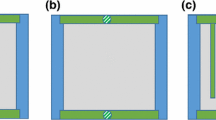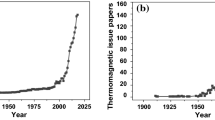Abstract
Weak link behavior in transition-edge sensor (TES) microcalorimeters creates the need for a more careful characterization of a device’s thermal characteristics through its transition. This is particularly true for small TESs where a small change in the bias current results in large changes in effective transition temperature. To correctly interpret measurements, especially complex impedance, it is crucial to know the temperature-dependent thermal conductance, G(T), and heat capacity, C(T), at each point through the transition. We present data illustrating these effects and discuss how we overcome the challenges that are present in accurately determining G and T from I–V curves. We also show how these weak link effects vary with TES size. Additionally, we use this improved understanding of G(T) to determine that, for these TES microcalorimeters, Kaptiza boundary resistance dominates the G of devices with absorbers while the electron-phonon coupling also needs to be considered when determining G for devices without absorbers




Similar content being viewed by others
References
J.E. Sadleir et al., Phys. Rev. Lett. 104, 047003 (2010)
S.J. Smith et al., J. Appl. Phys. (2011, submitted)
J.E. Sadleir et al., J. Low Temp. Phys. (2012). Special issue LTD14
S.J. Smith et al., J. Low Temp. Phys. (2012). Special issue LTD14
J.E. Sadleir et al., Phys. Rev. B 84, 184502 (2011)
S.R. Bandler et al., Proc. SPIE 7732, 773238 (2010)
S.J. Smith et al., J. Low Temp. Phys. (2012). doi:10.1007/s10909-012-0574-y. Special issue LTD14
M.E. Eckart et al., J. Low Temp. Phys. (2012). doi:10.1007/s10909-012-0514-x. Special issue LTD14
C.A. Kilbourne et al., J. Low Temp. Phys. 151, 223–228 (2008)
F.M. Finkbeiner et al., IEEE Trans. Appl. Supercond. 21, 223–226 (2011)
M.A. Lindeman et al., J. Low Temp. Phys. 151, 180–184 (2008)
E.T. Swartz, R.O. Pohl, Rev. Mod. Phys. 61, 605 (1989)
T.T. Haikkila, F. Giazotto, Phys. Rev. B 79, 094514 (2009)
Acknowledgements
This research was supported in part by an appointment to the NASA Postdoctoral Program at Goddard Space Flight Center (C.N. Bailey), administered by Oak Ridge Associated Universities through a contract with NASA.
Author information
Authors and Affiliations
Corresponding author
Rights and permissions
About this article
Cite this article
Bailey, C.N., Adams, J.S., Bandler, S.R. et al. Implications of Weak Link Effects on Thermal Characteristics of Transition-Edge Sensors. J Low Temp Phys 167, 121–128 (2012). https://doi.org/10.1007/s10909-012-0562-2
Received:
Accepted:
Published:
Issue Date:
DOI: https://doi.org/10.1007/s10909-012-0562-2




